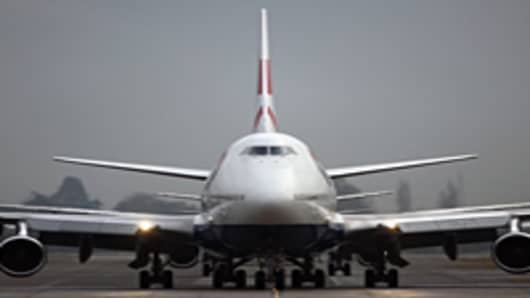Airline passengers on 18 domestic flights were stuck for lengthy delays on airport tarmacs in July, a rise in the number of tarmac delays from the first six months of this year.
The Transportation Department reported Monday that 16 of those delays were on July 13 on flights heading in or out of Chicago's O'Hare airport during severe thunderstorms. (Read more: Delayed: Chicago O'Hare International Airport)
The 15 largest U.S. airlines also did a poorer job of getting passengers to their destinations on time in July compared with the previous month.
Analysts say the results show how severe weather hitting the nation's second-busiest airport for takeoffs and landings can ripple across the country and contribute to delays.
"It's just kind of a snowball effect," says Martin Lauth, associate professor of Air Traffic Management at Embry-Riddle Aeronautical University. "All it takes is one storm and all of a sudden your delays for the month have gone up."
An international flight—a Caribbean Airlines flight from Georgetown, Guyana, to New York's JFK airport—also was delayed for more than four hours in July, the department said.
The department is investigating the tarmac delays because passengers on domestic flights aren't supposed to be held on planes for more than three hours, or for more than four hours on international flights without the option of getting off. (Read more: Are Rules Limiting Tarmac Delays Working?)
The government imposed limits on tarmac delays in April 2010 after passengers were stuck on planes for more than 10 hours in a series of incidents. And the number of delays has dropped significantly since then.
From January to June, there were just four lengthy domestic tarmac delays. Last year, there were 35 during the first six months. And in the first six months of 2009, there were 586 delays exceeding three hours.
Airlines face fines of up to $27,500 per passenger if they break the rules. Only one airline— American Eagle, regional unit of American Airlines—has had to pay fines. That, too, was the result of delays at Chicago O'Hare in May 2011. The airline paid $900,000.
Darryl Jenkins, airline analyst and chairman of the American Aviation Institute, says tarmac rules don't work when airlines face bad weather. "There's nothing you can do when a line of thunderstorms comes in," he says.
Justin Nisly, a spokesman for the Transportation Department, says the tarmac rule has been a win for consumers, despite July's showing. "We are very pleased that we've been able to nearly eliminate lengthy tarmac delays," he says.
On-time performance
After months of doing a better job of arriving on time, airlines were on time 76 percent of the time in July. That's down from June's 80.7 percent rate and July 2011's 77.8 percent. The carriers canceled 1.4 percent of their domestic flights in July. That's up from 1.1 percent in June, but down from 1.7 percent in July 2011.


